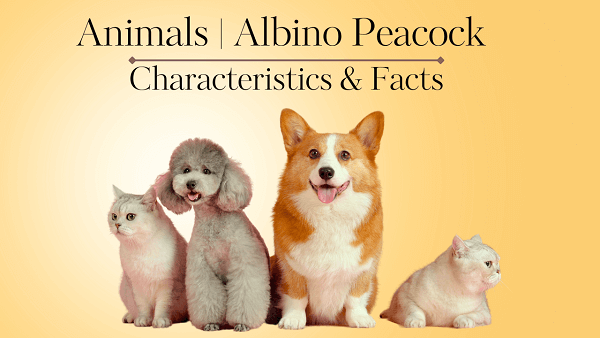Albino Peacock Definition | Characteristics & Facts
Home » Animals » Albino Peacock Definition | Characteristics & Facts
Albino Peacock Definition
The term “Albino peacock” refers to a genetic variation of the Indian peafowl (scientifically known as Pavo cristatus), which is a species of peafowl native to the Indian subcontinent. Albino peacocks are a color morph characterized by their lack of pigment, resulting in predominantly white plumage and pale-colored eyes.
They are the result of a genetic mutation that affects the production of melanin, the pigment responsible for the typical colorful plumage of peafowls.
Albino Peacock General Characteristics & Facts
General Characteristics & Facts of Albino Peacock:
Appearance
Albino peacocks are a color morph of the Indian peafowl (Pavo cristatus) characterized by their lack of pigment, resulting in predominantly white plumage. They have pale-colored eyes, and their train (tail feathers) lacks the typical vibrant blue and green colors seen in non-albino peacocks.
Genetic Mutation
Albino peacocks are the result of a genetic mutation that affects the production of melanin, the pigment responsible for color in feathers, skin, and eyes. This mutation prevents the synthesis of melanin, leading to their unique white appearance.
Rarity
Albino peacocks are relatively rare in the wild and in captivity. Their unique and ethereal appearance makes them highly prized and sought after by enthusiasts, zoos, and collectors.
Vulnerability
Due to their lack of melanin, albino peacocks are more susceptible to the damaging effects of sunlight, including sunburn and skin cancers. As a result, they may require special care and protection from excessive sun exposure when kept in captivity.
Behavior
Albino peacocks exhibit similar behaviors to their non-albino counterparts. They are known for their impressive courtship displays, especially during the breeding season, where the male displays its magnificent train to attract females.
Diet
Albino peacocks are omnivorous, like other peafowl, and feed on a variety of foods, including insects, plants, seeds, and small vertebrates.
Habitat
In the wild, Indian peafowls, including albino individuals, are native to the Indian subcontinent, where they inhabit a range of environments, including forests, grasslands, and agricultural areas.
Conservation Status
The Indian peafowl, including albino variants, is listed as “Least Concern” on the International Union for Conservation of Nature (IUCN) Red List, indicating that the species is not currently facing significant conservation threats.
Physical Characteristics of Albino Peacock
Physical Characteristics of Albino Peacock:
- Plumage: The most distinctive feature of albino peacocks is their predominantly white plumage. Unlike the typical Indian peafowl, which exhibits vibrant and iridescent colors, the feathers of albino peacocks lack pigmentation and are primarily white, with some faint hints of cream or light brown.
- Train (Tail Feathers): The train of the albino peacock refers to the long, elaborate tail feathers that are characteristic of male peafowls. In albino individuals, the train lacks the usual brilliant blue and green colors seen in non-albino peacocks. Instead, it is predominantly white, with less vibrant hues.
- Eyes: Albino peacocks have pale-colored eyes, which is another characteristic of albinism. Their eyes lack the usual dark pigmentation seen in the eyes of non-albino peafowls.
- Size: They have a total body length (including the tail) of about 4 to 5 feet (120 to 150 cm) and weigh between 8 to 13 pounds (3.5 to 6 kg).
- Crest: Both male and female albino peacocks have a crest on the top of their heads. The crest is composed of feathers that can be raised and lowered depending on the bird’s emotional state or level of arousal.
- Beak and Legs: The beak of albino peacocks is relatively long and pointed, suitable for foraging and capturing food. Their legs are sturdy and equipped with sharp claws that aid in perching and walking on various surfaces.
- Vocalizations: Albino peacocks, like other Indian peafowls, produce distinct vocalizations. The males are known for their loud, resonating calls, which are part of their courtship display to attract females.
- Sexual Dimorphism: Sexual dimorphism is not as apparent in albino peacocks as it is in non-albino peafowls due to the lack of color variation.
Continue To Explore All Animals That Start With A
Scientific Classification of Albino Peacock
Kingdom: Animalia
Phylum: Chordata
Class: Aves
Order: Galliformes
Family: Phasianidae
Genus: Pavo
Species: Pavo cristatus
View All A-Z Animals List
Albino Peacock FAQs
What does an Albino Peacock eat?
- Insects
- Seeds and Grains
- Fruits and Berries
- Vegetables
- Small Vertebrates



